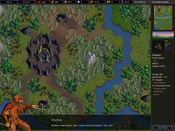Orcs

| |
| Faction(s) | Northerners |
| Alignment(s) | Chaotic |
| Race tree | 1.12 |
Contents |
In appearance, orcs are half men and half beasts. They are taller, sturdier and stronger than humans. They are warlike, savage, and cruel by nature. Their blood is darker and thicker than that of normal humans and they have little care for personal hygiene or their personal appearance. Although Orcs are violent even among themselves creatures, they are pack-oriented; an orc never travels long or lives alone in groups smaller than half a dozen.
Society
Almost every orc is a member of a tribe or a clan. Relations between neighbouring tribes are usually violent, except in cases of a mutual enemy threatens their existence or prospects of great plunder override mutual animosity. Occasionally, a single strong chieftain may emerge to lead multiple tribes from time to time, usually through intimidation of followers. An orc tribe in times of peace tends to focus almost solely on strengthening itself in preparation for the next armed conflict. Orcs are known to possess a crude system of writing - usually in blood - although it's most commonly used to trade insults or threats among tribal leaders.
Orc societies are based on little else but strength; might makes right, and a leader leads and survives only as long as no one manages to wrest the title from him. A constant struggle for power simmers among potential tribal chiefs. An orcish leader rarely lives more than a handful of years to enjoy his absolute authority before being killed for his position - although history knows some notable exceptions. Orcs hold no particular honour code and while undisputable raw strength is usually the preferred method of displaying power, assassination, poisoning and backstabbing are completely viable means to further one's own goals.
Orcs mostly live in rural areas, often in foothills or mountainous regions, sometimes in caves. They grow no crops nor keep livestock, but are competent hunters as a result of their physical stature and brutality. Due to their large numbers they are capable of hunting an area virtually clean of anything larger than rodents in relatively short period of time. Due to this and their unstable leadership, orcish tribes tend to lead a semi-nomadic lifestyle, never settling in one region for too long. The larger tribes may establish themselves firmly in an area for years or even decades and build large encampments almost resembling cities, but even these are easily dismantled and abandoned if there is a need to relocate the horde.
The oldest known orcs have been around 50 to 60 years of age, but very few individuals ever live to see over two or three decades before meeting their end either in war or by the hand of one of their kin. The oldest orcs are often shamans, which are perhaps the only ones most of their kind sees as being trustworthy and neutral. The origins of this custom are unknown, as the shamans do not directly contribute much to orcish societies but only act as advisors - not something orcs tend to otherwise tolerate. Shamans are in many ways the opposite of most other orcs: they are often physically withered and frail in comparison and lack skill in battle. Despite their reliance on raw strength, not nearly all orcs are destined to grow to possess any. Many orcs are born smaller and weaker than the rest, and already almost as newborns are put in their place by their stronger siblings. The stronger ones will routinely grab most of the food and thus grow stronger still, while their weaker siblings do not. Many of these individuals tend to specialize in other skills, like archery or assassination.
Goblins
Goblins are, despite their appearance, born as siblings to the orcs and members of the same race. While other races usually bear children singly or in pairs, orcs will have large litters of children all at once, causing their populations to explode rather quickly. Within any litter, there will only be one or two true orcs, who will grow to the full size and strength of their race. A few more will be half-orcs, notably weaker than their big brothers, and relegated to supporting roles in combat, such as archery. The rest, often a full half of more of any litter, will be goblins. Goblins are puny and quite frail, rarely growing past the size and stature of a human child. Goblins are born into a lifetime of near-slavery to their larger kin, and used as sword-fodder in battle. They thrive in spite of their tragic fate; in part because they are so very numerous, and also because their brother orcs are well aware how dependent they are on the goblins.
Goblins perform the bulk of manual labor needed by the orcs, with the sole exception of jobs that require the brute strength of true orcs. Those the orcs revel in as proof of their prowess.
See also
| Races of Wesnoth |
|---|
|
Major: Drakes • Dwarves • Elves • Humans • Orcs • Undead Minor: Merfolk • Nagas • Ogres • Saurians • Trolls • Woses • Monsters |
